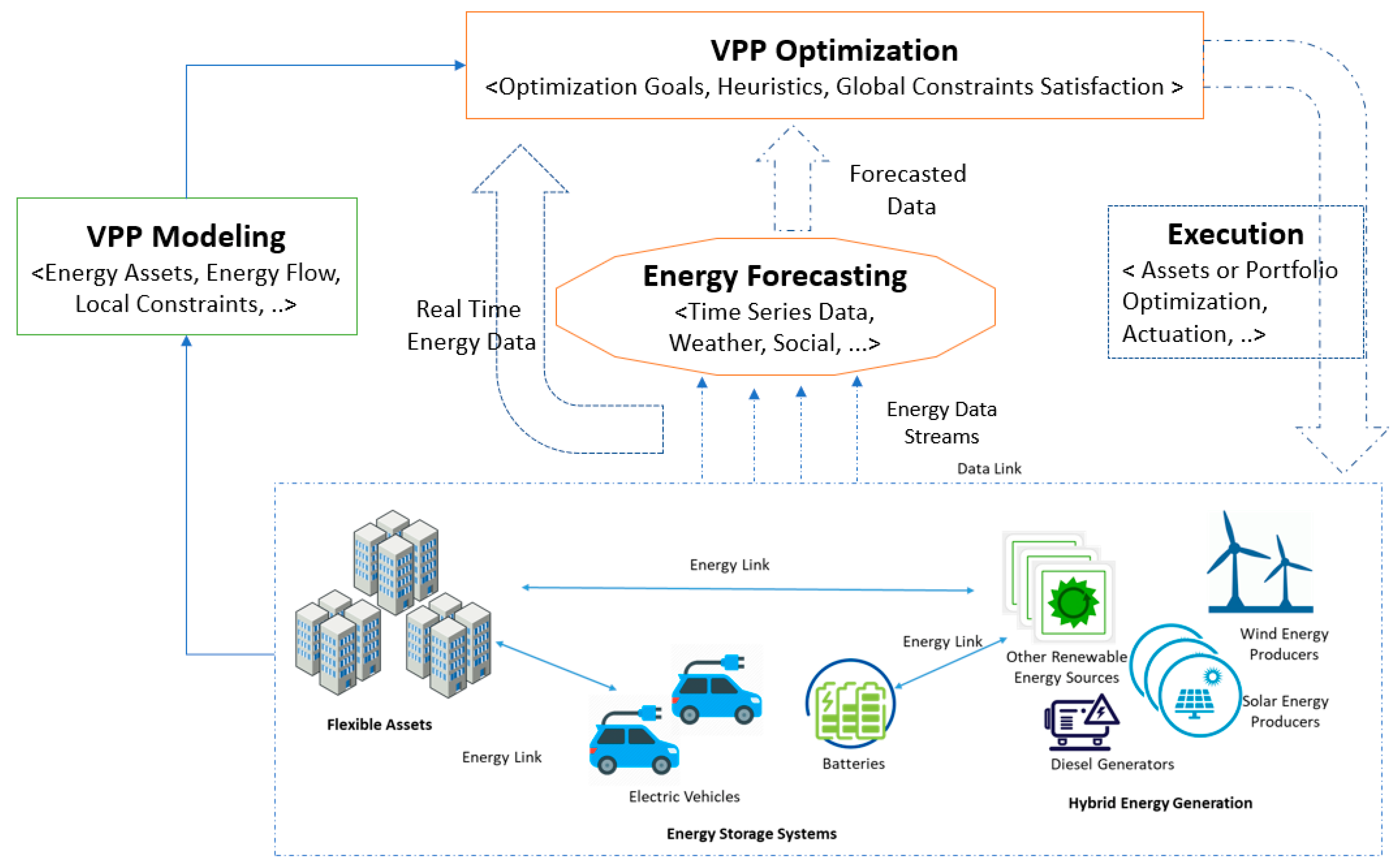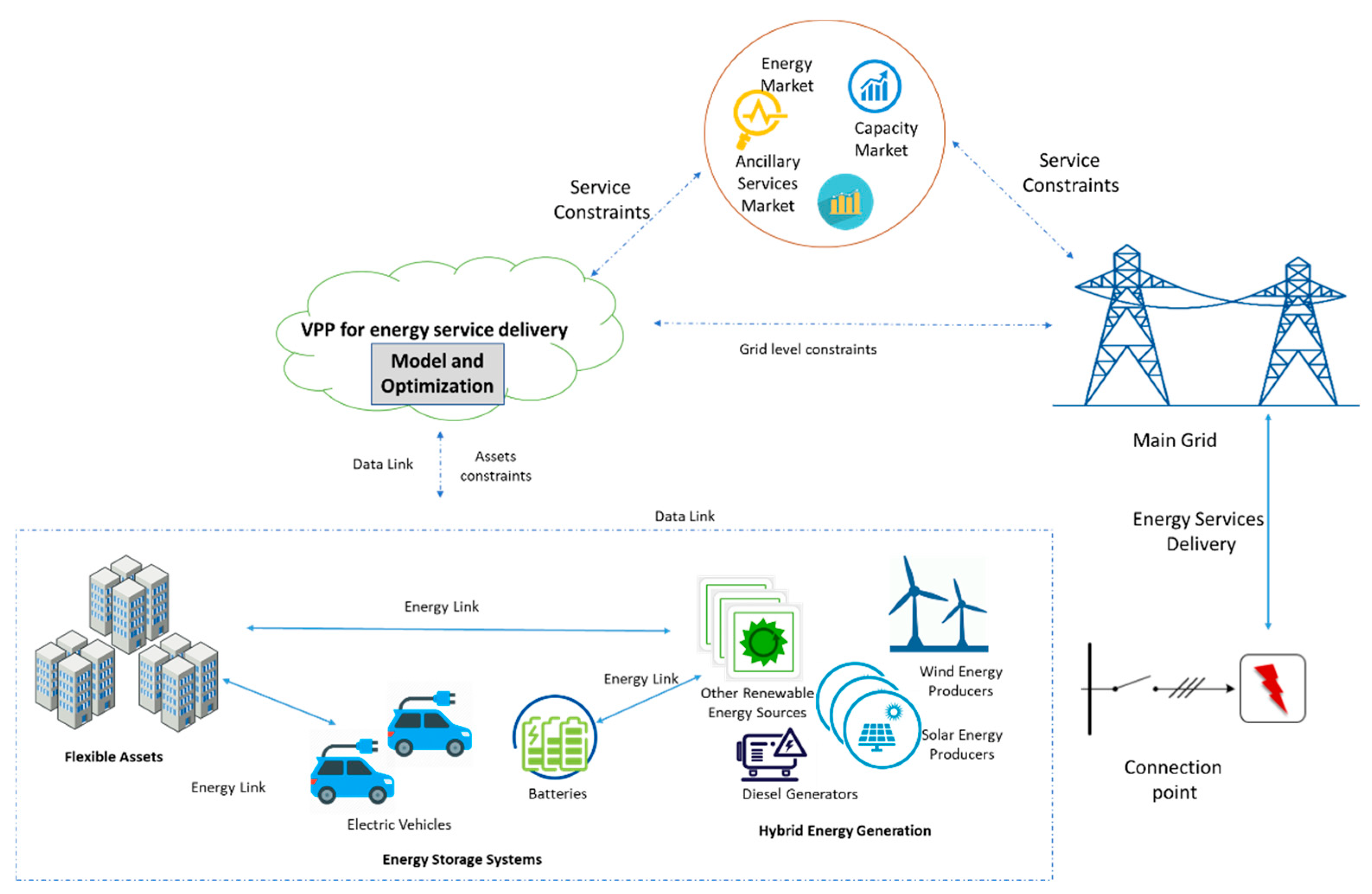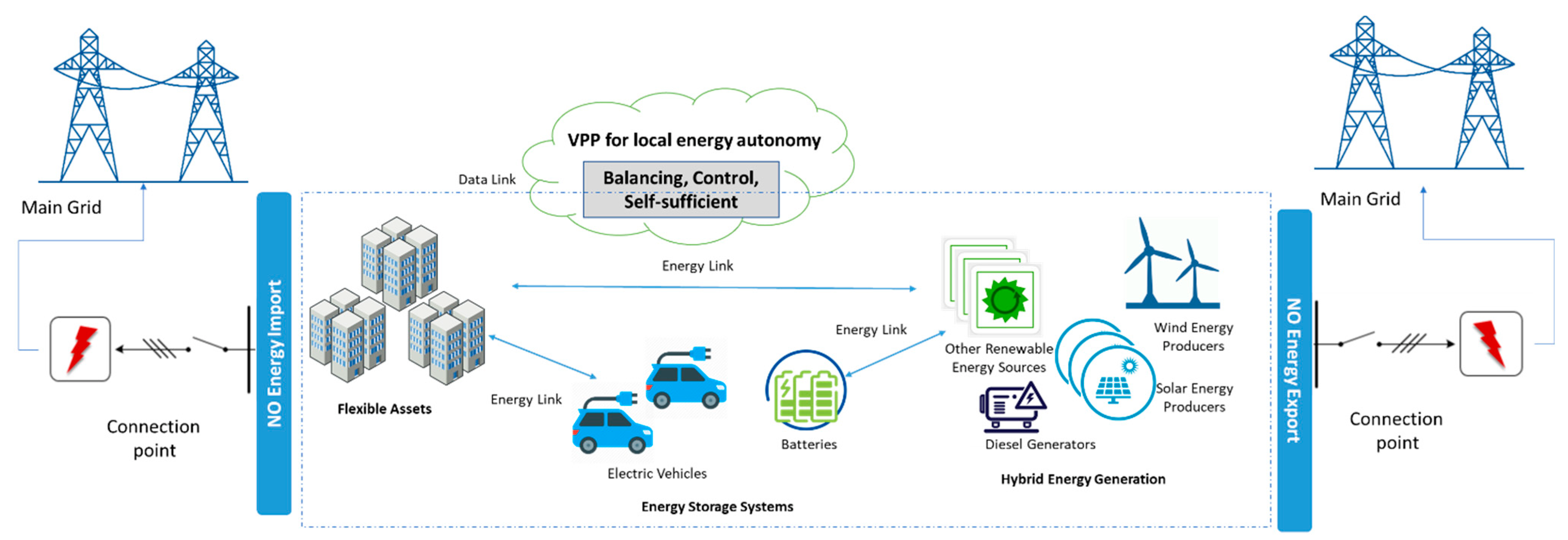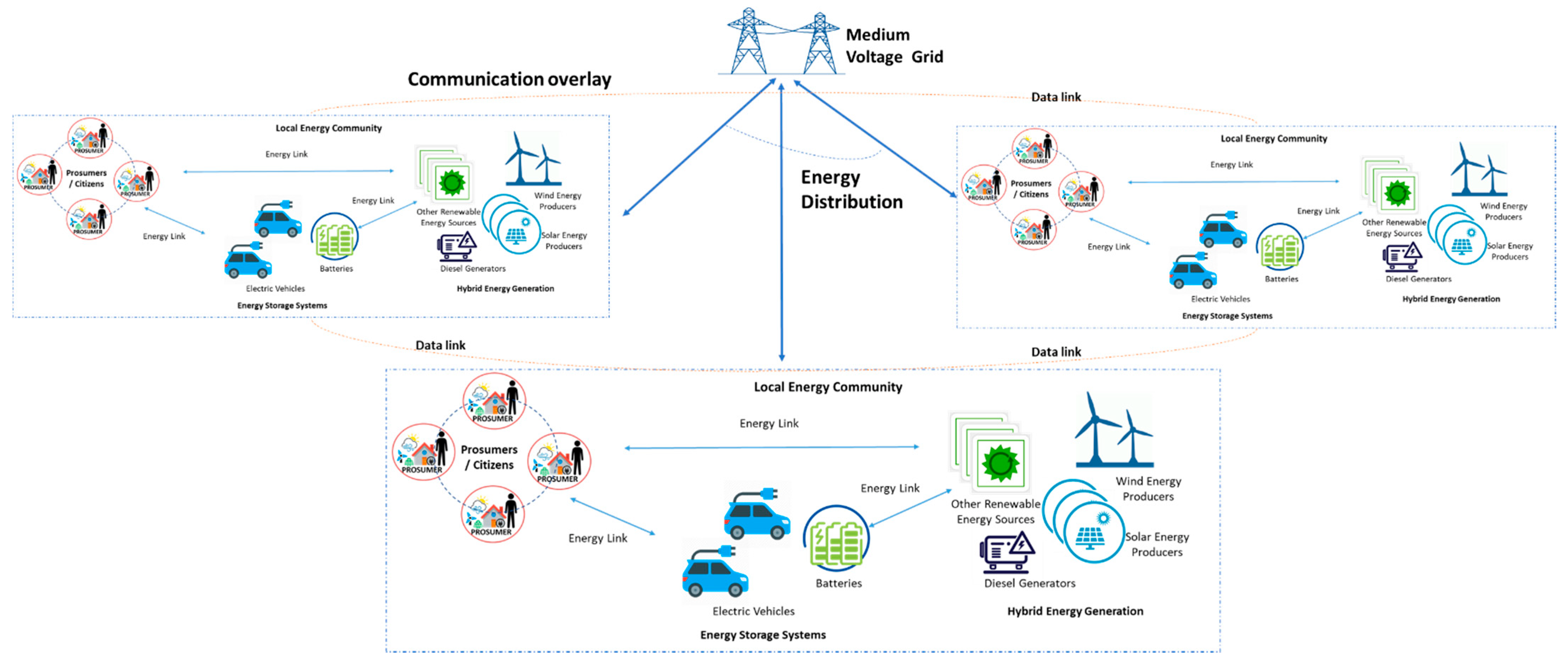
| Version | Summary | Created by | Modification | Content Size | Created at | Operation |
|---|---|---|---|---|---|---|
| 1 | Tudor Cioara | -- | 1985 | 2022-05-26 17:45:32 | | | |
| 2 | Lindsay Dong | Meta information modification | 1985 | 2022-05-27 04:52:38 | | |
Video Upload Options
Virtual power plants (VPPs) are promising solutions to address the decarbonization and energy efficiency goals in the smart energy grid. They assume the coordination of local energy resources such as energy generation, storage, and consumption. They are used to tackle problems brought by the stochastic nature of renewable energy, lack of energy storage devices, or insufficient local energy flexibility on the demand side. VPP modeling, management, and optimization are open to research problems that should consider, on one side, the local constraints in the operation of the energy resources and power flows and the energy grid’s sustainability objectives on the other side. There are multiple goals to create a VPP, such as to deliver energy services on a market or to the grid operator, to operate a microgrid in autonomy decoupled from the main grid, or to sustain local energy communities.
1. Introduction
The concept of virtual power plants (VPPs) has been proposed and used lately as a solution for assuring an affordable, secure, and steady supply of energy in the smart grid [1]. It aims at combining and coordinating energy production with storage and consumption resources featuring controllable loads in an optimal way to meet renewable integration or energy costs minimization objectives. The associated optimization problem is usually addressed in the literature using various heuristics [2]. VPPs consider the predicted energy demand and production values for different resources, the operational, power flow, and cost constraints. They virtually aggregate resources to participate in energy markets, plan their operation in advance to deliver energy services, aggregate energy profiles for a steady supply and provide demand response services.
There are many works that that focus on creating such VPPs and optimally interacting them in various smart energy grid scenarios [3][4]. At the same time there are multiple ways to create a VPP that offer solutions for the energy market such as energy service delivery, energy autonomy, energy community, energy management or energy optimization, each of them with different purposes and steps to achieve a balance in the markets [1]. In order to establish which is the best approach for different situations, a requirements engineering solution has to be used where the starting point is the scenarios that describe the issue, in this case the energy consumption, and how to ensure stability and balance in the energy market, and the solution for it, represented in this case by the energy that can be provided from renewable resources which can sustain the economy and the market if a VPP is created in the architecture.
2. VPP Concept and Technology

2.1. Digital Twins’ Models
2.2. Energy Forecasting
2.3. Optimization and Coordination
3. VPP Applications in Smart Grids
-
VPP coordinates energy resources for collectively providing energy services in different markets or directly to interested stakeholders such as a DSO;
-
VPP coordinates energy resources for local energy autonomy to achieve an optimal balance between the demand and supply and to minimize energy exchanges among microgrids and the main grid;
-
VPP coordinates energy resources for the optimal implementation of sustainable energy communities considering in addition to energy aspects the local economic and social factors.
3.1. Energy Services Delivery

3.2. Local Energy Autonomy

3.3. Energy Communities’ Sustainability

References
- Naval, N.; Yusta, J.M. Virtual power plant models and electricity markets—A review. Renew. Sustain. Energy Rev. 2021, 149, 111393.
- Oest, F.; Radtke, M.; Blank-Babazadeh, M.; Holly, S.; Lehnhoff, S. Evaluation of Communication Infrastructures for Distributed Optimization of Virtual Power Plant Schedules. Energies 2021, 14, 1226.
- Sarmiento-Vintimilla, J.C.; Torres, E.; Larruskain, D.M.; Pérez-Molina, M.J. Applications, Operational Architectures and Development of Virtual Power Plants as a Strategy to Facilitate the Integration of Distributed Energy Resources. Energies 2022, 15, 775.
- Bhuiyan, E.A.; Hossain, Z.; Muyeen, S.; Fahim, S.R.; Sarker, S.K.; Das, S.K. Towards next generation virtual power plant: Technology review and frameworks. Renew. Sustain. Energy Rev. 2021, 150, 111358.
- Escobar, J.J.M.; Matamoros, O.M.; Padilla, R.T.; Reyes, I.L.; Espinosa, H.Q. A Comprehensive Review on Smart Grids: Challenges and Opportunities. Sensors 2021, 21, 6978.
- Ferro, G.; Laureri, F.; Minciardi, R.; Robba, M. Optimal control of demand response in a smart grid. In Proceedings of the 2017 25th Mediterranean Conference on Control and Automation (MED), Valletta, Malta, 3–6 July 2017; p. 516.
- Anthony, B.; Petersen, S.A.; Ahlers, D.; Krogstie, J.; Livik, K. Big data-oriented energy prosumption service in smart community districts: A multi-case study perspective. Energy Informatics 2019, 2, 1–26.
- Ferro, G.; Minciardi, R.; Parodi, L.; Robba, M.; Rossi, M. Optimal coordination of buildings and microgrids by an aggregator: A bi-level approach. IFAC-PapersOnLine 2020, 53, 16587–16592.
- Park, S.-W.; Son, S.-Y. Interaction-based virtual power plant operation methodology for distribution system operator’s voltage management. Appl. Energy 2020, 271, 115222.
- Onile, A.E.; Machlev, R.; Petlenkov, E.; Levron, Y.; Belikov, J. Uses of the digital twins concept for energy services, intelligent recommendation systems, and demand side management: A review. Energy Rep. 2021, 7, 997–1015.
- Sleiti, A.K.; Kapat, J.S.; Vesely, L. Digital twin in energy industry: Proposed robust digital twin for power plant and other complex capital-intensive large engineering systems. Energy Rep. 2022, 8, 3704–3726.
- Borowski, P. Digitization, Digital Twins, Blockchain, and Industry 4.0 as Elements of Management Process in Enterprises in the Energy Sector. Energies 2021, 14, 1885.
- Fuller, A.; Fan, Z.; Day, C.; Barlow, C. Digital Twin: Enabling Technologies, Challenges and Open Research. IEEE Access 2020, 8, 108952–108971.
- Wu, Y.; Zhang, K.; Zhang, Y. Digital Twin Networks: A Survey. IEEE Internet Things J. 2021, 8, 13789–13804.
- Kaewunruen, S.; Rungskunroch, P.; Welsh, J. A Digital-Twin Evaluation of Net Zero Energy Building for Existing Buildings. Sustainability 2018, 11, 159.
- Clausen, A.; Arendt, K.; Johansen, A.; Sangogboye, F.C.; Kjærgaard, M.B.; Veje, C.T.; Jørgensen, B.N. A digital twin framework for improving energy efficiency and occupant comfort in public and commercial buildings. Energy Inform. 2021, 4, 1–19.
- Bazmohammadi, N.; Madary, A.; Vasquez, J.C.; Mohammadi, H.B.; Khan, B.; Wu, Y.; Guerrero, J.M. Microgrid Digital Twins: Concepts, Applications, and Future Trends. IEEE Access 2021, 10, 2284–2302.
- Fathy, Y.; Jaber, M.; Nadeem, Z. Digital Twin-Driven Decision Making and Planning for Energy Consumption. J. Sens. Actuator Networks 2021, 10, 37.
- Xu, B.; Wang, J.; Wang, X.; Liang, Z.; Cui, L.; Liu, X.; Ku, A.Y. A case study of digital-twin-modelling analysis on power-plant-performance optimizations. Clean Energy 2019, 3, 227–234.
- Abideen, A.Z.; Sundram, V.P.K.; Pyeman, J.; Othman, A.K.; Sorooshian, S. Digital Twin Integrated Reinforced Learning in Supply Chain and Logistics. Logistics 2021, 5, 84.
- Duc, H.N.; Hong, N.N. Optimal Reserve and Energy Scheduling for a Virtual Power Plant Considering Reserve Activation Probability. Appl. Sci. 2021, 11, 9717.
- Popławski, T.; Dudzik, S.; Szeląg, P.; Baran, J. A Case Study of a Virtual Power Plant (VPP) as a Data Acquisition Tool for PV Energy Forecasting. Energies 2021, 14, 6200.
- Talari, S.; Shafie-Khah, M.; Osório, G.J.; Aghaei, J.; Catalão, J.P.S. Stochastic modelling of renewable energy sources from operators’ point-of-view: A survey. Renew. Sustain. Energy Rev. 2018, 81, 1953–1965.
- Khan, P.W.; Kim, Y.; Byun, Y.-C.; Lee, S.-J. Influencing Factors Evaluation of Machine Learning-Based Energy Consumption Prediction. Energies 2021, 14, 7167.
- Da Silva, D.G.; Geller, M.T.B.; dos Santos Moura, M.S. Anderson Alvarenga de Moura Meneses, Performance Evaluation of LSTM Neural Networks for Consumption Prediction. E Prime Adv. Electr. Eng. Electron. Energy 2022, 2, 100030.
- Agga, A.; Abbou, A.; Labbadi, M.; El Houm, Y.; Ali, I.H.O. CNN-LSTM: An efficient hybrid deep learning architecture for predicting short-term photovoltaic power production. Electr. Power Syst. Res. 2022, 208, 107908.
- Saeed, F.; Paul, A.; Seo, H. A Hybrid Channel-Communication-Enabled CNN-LSTM Model for Electricity Load Forecasting. Energies 2022, 15, 2263.
- Tovar, M.; Robles, M.; Rashid, F. PV Power Prediction, Using CNN-LSTM Hybrid Neural Network Model. Case of Study: Temixco-Morelos, México. Energies 2020, 13, 6512.
- Shachee, S.B.; Latha, H.N.; Hegde Veena, N. Electrical Energy Consumption Prediction Using LSTM-RNN. In Evolutionary Computing and Mobile Sustainable Networks. Lecture Notes on Data Engineering and Communications Technologies; Suma, V., Fernando, X., Du, K.L., Wang, H., Eds.; Springer: Singapore, 2022; Volume 116.
- Pop, C.; Antal, M.; Cioara, T.; Anghel, I.; Salomie, I.; Bertoncini, M. Pop A Fog Computing enabled Virtual Power Plant Model for Delivery of Frequency Restoration Reserve Services. Sensors 2019, 19, 4688.
- Hooshmand, R.-A.; Nosratabadi, S.M.; Gholipour, E. Event-based scheduling of industrial technical virtual power plant considering wind and market prices stochastic behaviors—A case study in Iran. J. Clean. Prod. 2018, 172, 1748–1764.
- Kasaei, M.J.; Gandomkar, M.; Nikoukar, J. Optimal management of renewable energy sources by virtual power plant. Renew. Energy 2017, 114, 1180–1188.
- Sharma, H.; Mishra, S.; Dhillon, J.; Sharma, N.K.; Bajaj, M.; Tariq, R.; Rehman, A.U.; Shafiq, M.; Hamam, H. Feasibility of Solar Grid-Based Industrial Virtual Power Plant for Optimal Energy Scheduling: A Case of Indian Power Sector. Energies 2022, 15, 752.
- Taheri, S.I.; Salles, M.B.C.; Costa, E.C.M. Optimal Cost Management of Distributed Generation Units and Microgrids for Virtual Power Plant Scheduling. IEEE Access 2020, 8, 208449–208461.
- Shabanzadeh, M.; Eslami, M.; Haghifam, M.-R. An interactive cooperation model for neighboring virtual power plants. Appl. Energy 2017, 200, 273–289.
- Zamani, A.G.; Zakariazadeh, A.; Jadid, S. Day-ahead resource scheduling of a renewable energy based virtual power plant. Appl. Energy 2016, 169, 324–340.
- Duan, J.; Wang, X.; Gao, Y.; Yang, Y.; Yang, W.; Li, H.; Ehsan, A. Multi-Objective Virtual Power Plant Construction Model Based on Decision Area Division. Appl. Sci. 2018, 8, 1484.
- Rädle, S.; Mast, J.; Gerlach, J.; Bringmann, O. Computational intelligence based optimization of hierarchical virtual power plants. Energy Syst. 2021, 12, 517–544.
- Howell, S.; Rezgui, Y.; Hippolyte, J.-L.; Jayan, B.; Li, H. Towards the next generation of smart grids: Semantic and holonic multi-agent management of distributed energy resources. Renew. Sustain. Energy Rev. 2017, 77, 193–214.
- Naughton, J.; Wang, H.; Riaz, S.; Cantoni, M.; Mancarella, P. Optimization of multi-energy virtual power plants for providing multiple market and local network services. Electr. Power Syst. Res. 2020, 189, 106775.
- Zhang, M.; Xu, Q.; Zhang, C.; Blaabjerg, F. Decentralized Coordination and Stabilization of Hybrid Energy Storage Systems in DC Microgrids. IEEE Trans. Smart Grid 2022, 1.
- H2020 eDREAM, Deliverable D3.3-Consumption Flexibility Models and Aggregation Techniques. Available online: https://edream-h2020.eu/wp-content/uploads/2019/07/eDREAM.D3.3.TUC_.WP3_.V1.0-compressed.pdf (accessed on 19 April 2022).
- Trivedi, R.; Patra, S.; Sidqi, Y.; Bowler, B.; Zimmermann, F.; Deconinck, G.; Papaemmanouil, A.; Khadem, S. Community-Based Microgrids: Literature Review and Pathways to Decarbonise the Local Electricity Network. Energies 2022, 15, 918.
- Bianchi, S.; De Filippo, A.; Magnani, S.; Mosaico, G.; Silvestro, F. VIRTUS Project: A Scalable Aggregation Platform for the Intelligent Virtual Management of Distributed Energy Resources. Energies 2021, 14, 3663.
- Behi, B.; Arefi, A.; Jennings, P.; Gorjy, A.; Pivrikas, A. Advanced Monitoring and Control System for Virtual Power Plants for Enabling Customer Engagement and Market Participation. Energies 2021, 14, 1113.
- Gamma, K.; Mai, R.; Cometta, C.; Loock, M. Engaging customers in demand response programs: The role of reward and punishment in customer adoption in Switzerland. Energy Res. Soc. Sci. 2021, 74, 101927.
- Van Summeren, L.F.; Wieczorek, A.J.; Bombaerts, G.J.; Verbong, G.P. Community energy meets smart grids: Reviewing goals, structure, and roles in Virtual Power Plants in Ireland, Belgium and the Netherlands. Energy Res. Soc. Sci. 2020, 63, 101415.
- Ravi, S.S.; Aziz, M. Utilization of Electric Vehicles for Vehicle-to-Grid Services: Progress and Perspectives. Energies 2022, 15, 589.




